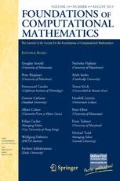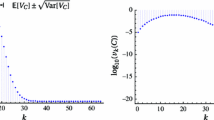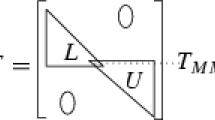Abstract
We consider the conic feasibility problem associated with the linear homogeneous system Ax≤0, x≠0. The complexity of iterative algorithms for solving this problem depends on a condition number C(A). When studying the typical behavior of algorithms under stochastic input, one is therefore naturally led to investigate the fatness of the tails of the distribution of C(A). Introducing the very general class of uniformly absolutely continuous probability models for the random matrix A, we show that the distribution tails of C(A) decrease at algebraic rates, both for the Goffin–Cheung–Cucker number C G and the Renegar number C R . The exponent that drives the decay arises naturally in the theory of uniform absolute continuity, which we also develop in this paper. In the case of C G , we also discuss lower bounds on the tail probabilities and show that there exist absolutely continuous input models for which the tail decay is subalgebraic.
Similar content being viewed by others
References
K.M. Anstreicher, J. Ji, F.A. Potra, Y. Ye, Probabilistic analysis of an infeasible-interior-point algorithm for linear programming, Math. Oper. Res. 24(1), 176–192 (1999).
A. Blum, J. Dunagan, Smoothed analysis of the perceptron algorithm for linear programming, in SODA’02, pp. 905–914 (2002).
L. Blum, F. Cucker, M. Shub, S. Smale, Complexity and Real Computation (Springer, Berlin, 1998).
K.H. Borgwardt, Some distribution–independent results about the asymptotic order of the average number of pivot steps of the simplex method, Math. Oper. Res. 7, 441–462 (1982).
D. Cheung, F. Cucker, A new condition number for linear programming, Math. Program. 91, 163–174 (2001).
D. Cheung, F. Cucker, R. Hauser, Tail decay and moment estimates of a condition number for random linear conic systems, SIAM J. Optim. 15(4), 1237–1261 (2005).
F. Cucker, J. Peña, A primal-dual algorithm for solving polyhedral conic systems with a finite-precision machine, SIAM J. Optim. 12, 522–554 (2002).
F. Cucker, M. Wschebor, On the expected condition number of linear programming problems, Numer. Math. 94, 419–478 (2002).
J. Dunagan, D.A. Spielman, S.-H. Teng, Smoothed analysis of Renegar’s condition number for linear programming. Preprint http://theory.lcs.mit.edu/~spielman (2003).
J. Dunagan, S. Vempala, A simple polynomial-time rescaling algorithm for solving linear programs, in Proceedings of the 36th Annual ACM Symposium on Theory of Computing, pp. 315–320 (2004).
H. Federer, Geometric Measure Theory (Springer, Berlin, 1969).
J.-L. Goffin, On the finite convergence of the relaxation method for solving systems of inequalities. Ph.D. thesis, University of California, Berkeley (1971).
J.-L. Goffin, The relaxation method for solving systems of linear inequalities, Math. Oper. Res. 5, 388–414 (1980).
R. Hauser, T. Müller, Algebraic tail decay of condition numbers for random conic systems under a general family of input distributions. Numerical Analysis Group Research Report NA-06/01, Oxford University Computing Laboratory (2006).
P. Huhn, K.H. Borgwardt, An upper bound for the average number of iterations required in phase II of an interior-point-method, in Operations Research Proceedings 1997 (Jena) (Springer, Berlin, 1998), pp. 19–24.
P. Huhn, K.H. Borgwardt, Interior-point methods: worst case and average case analysis of a phase-I algorithm and a termination procedure, J. Complex. 18(3), 833–910 (2002).
J. Renegar, Linear programming, complexity theory and elementary functional analysis, Math. Program. 70, 279–351 (1995).
R. Rosenblatt, Principles of Neurodynamics: Perceptrons and the Theory of Brain Mechanisms (Spartan Books, Washington, 1962).
S.M. Ross, Probability Models in Computer Science (Harcourt/Academic Press, San Diego, 2002).
S. Smale, On the average number of steps of the simplex method of linear programming, Math. Program. 27, 241–262 (1983).
D. Spielman, S. Teng, Smoothed analysis: Why the simplex algorithm usually takes polynomial time, J. Assoc. Comput. Mach. 51, 385–463 (2004).
M.J. Todd, L. Tunçel, Y. Ye, Characterizations, bounds and probabilistic analysis of two complexity measures for linear programming problems, Math. Program. 90, 59–69 (2001).
Author information
Authors and Affiliations
Corresponding author
Additional information
Communicated by Felipe Cucker and Mike Todd.
R. Hauser was supported by a grant of the Nuffield Foundation under the “Newly Appointed Lecturers” grant scheme (project number NAL/00720/G) and through grant GR/S34472 from the Engineering and Physical Sciences Research Council of the UK.
The research in this paper was conducted while T. Müller was a research student at the University of Oxford. He was partially supported by EPSRC, the Oxford University Department of Statistics, Bekker-la-Bastide fonds, Dr. Hendrik Muller’s Vaderlandsch fonds, and Prins Bernhard Cultuurfonds.
Rights and permissions
About this article
Cite this article
Hauser, R., Müller, T. Conditioning of Random Conic Systems Under a General Family of Input Distributions. Found Comput Math 9, 335–358 (2009). https://doi.org/10.1007/s10208-008-9034-0
Received:
Revised:
Accepted:
Published:
Issue Date:
DOI: https://doi.org/10.1007/s10208-008-9034-0
Keywords
- Condition numbers
- Random matrices
- Linear programming
- Conic feasibility problem
- Probabilistic analysis
- Smoothed analysis




